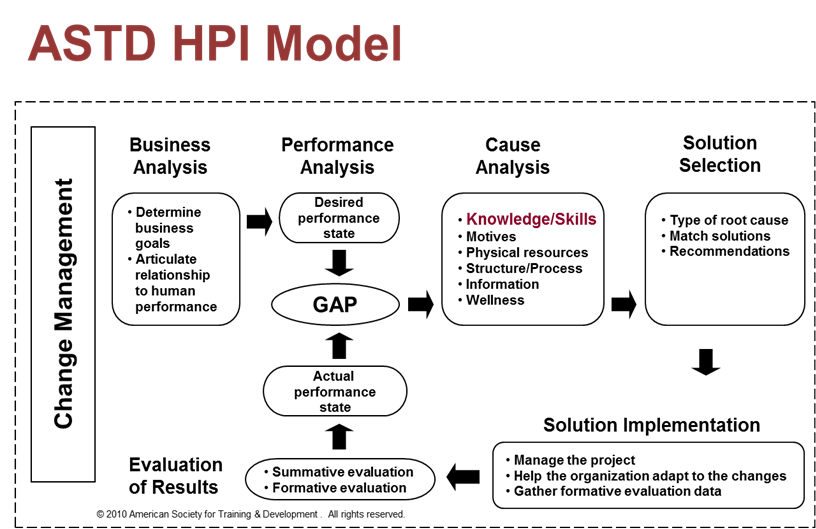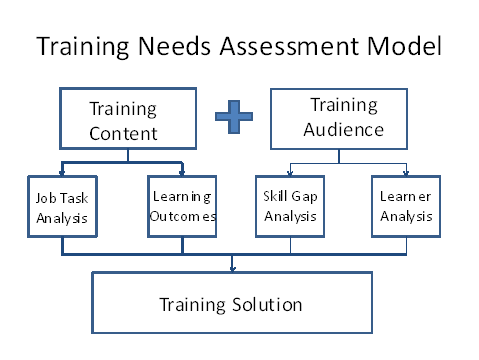While training professionals have many ways to design and deliver learning, we all know that we should start the training process the same way – by analyzing the need. When presented with a potential training opportunity, we first must determine what has created this opportunity and how the organization should expend its resources to address it.
In conducting an initial analysis, we have several decisions to make. First, we need to decide whether training is an appropriate solution. If it is, then we need to decide what content to include and finally, who needs to receive training. Each of these decisions can be supported by a growing number of models and tools that provide guidance and structure to our work. In particular, two models have emerged to guide our analysis – the Human Performance Improvement (HPI) model and the Training Needs Assessment (TNA) model.

The HPI model refers to a systematic problem solving process that focuses on identifying root causes of complex performance problems and implementing systemic solutions. One of the key tenets of HPI philosophy is that we do not assume that training or any other particular solution is the answer to an organization’s problem until we have collected and analyzed evidence to support it. Another key tenet is that work performance is a complex system of attitudes, behaviors and accomplishments that depends upon both organizational and individual factors for success.
As the HPI model illustrates, performance analysis is divided into three phases – business, performance and cause. The business analysis determines the organization’s goals and how they relate to the performance of employees. This establishes the bottom-line results that we are trying to achieve. The performance analysis establishes the gap between where we are (actual state) and where we need to be (desired state). Finally, the cause analysis examines a variety of possible root causes to isolate those most likely creating the performance gap.
Under cause analysis, note that knowledge/skills is only one of six key causes of performance problems. Unless we have evidence that a lack of knowledge or skill is contributing to the performance gap, we do not have a problem that training can solve. Put positively, we should only conduct training when we have evidence of a knowledge or skill gap. Providing training when the root cause is something else – lack of motivation, resources, structure, information or wellness – is just setting ourselves up for failure.

Once we have established that a knowledge/skill gap exists, however, we are ready to move to the Training Needs Assessment (TNA) model to further specify the need. Many different TNA models exist. Some are process-driven; others focus on outcomes and methods. Each of these models, however different in conception and approach, is designed to accomplish two things:
- Define the content of the training
- Define the audience for the training
The model below shows how both of these key outcomes are created through a series of processes that lead to a fully-conceptualized training solution, the end product of training needs assessment.
To understand how this works, consider the four boxes in the middle of the model. For content, we typically rely on two processes – job task analysis and establishing learning outcomes. Learning outcomes may be provided by the requesting client, key stakeholders or external mandates. We usually arrive at these through interviews and document review. Job tasks analysis is a process that breaks jobs into outcomes, outcomes into tasks, tasks into steps, and steps into knowledge (see figure). Once we document these thoroughly through interviews and observation, we have the course domain. We can then match this up with the desired learning outcomes to determine the precise subject matter of the training.

To analyze the training audience, we also rely on two key processes – skill gap analysis and learner analysis. Learner analysis is the process of defining the specific needs of the proposed target audience, including: prerequisite knowledge/skill levels, learning motivation, preferred learning styles, cultural differences, physical and environmental constraints, etc. This is often assembled through a combination of interviews and surveys. The skill gap analysis looks at the gap between the existing skill level of the target audience and the required skill level based on the organization’s needs and job standards. As a rule of thumb, the larger the skill gap, the more expensive and time-consuming is the training solution. Skill gap analysis thus helps us estimate the time requirements while focusing on the highest priority content areas.

Once we complete this analysis work, we are ready to assemble the pieces into a training solution that we take back to our client for approval. This takes us to the end of analysis. If we’ve done a good job, we will get approval to move to the next step – learning design.
While we know how important analysis is to our process, clients often do not realize this. They may impatiently question why we are taking up their time analyzing the problem. They may wish to direct us to a solution without any analysis, relying on gut instinct. We will need to carefully explain the benefits of analysis in these cases or else risk seeing the process shortchanged or skipped altogether.
One tactic that has worked for me is to use the analogy of a medical doctor. If you feel sick, but don’t know why, you expect your doctor to perform a diagnosis, complete with tests, prior to naming your illness and prescribing a plan of treatment. In fact, treatment without diagnosis is considered malpractice in the world of medicine. Likewise, if we provide treatment (training) without any diagnosis (analysis) we run the risk of professional malpractice. Although our treatments are rarely life-threatening (aside from the occasional death-by-PowerPoint), they do consume valuable time and resources at a moment when organizations can ill afford to waste either.